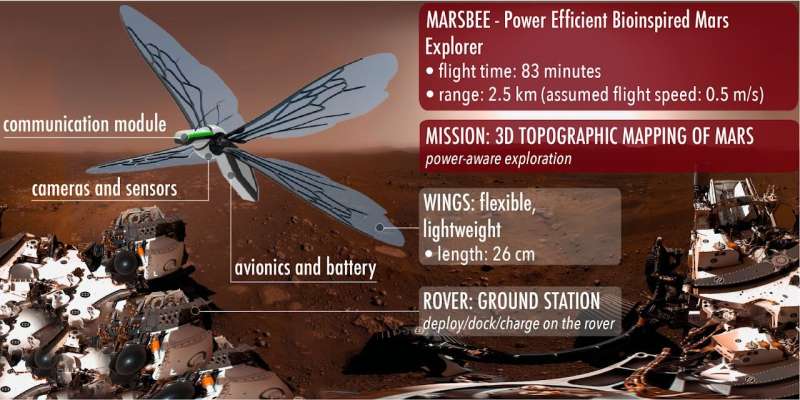This article has been reviewed according to Science X's editorial process and policies. Editors have highlighted the following attributes while ensuring the content's credibility:
fact-checked
trusted source
proofread
Could we replace Ingenuity with a swarm of robotic bees?

Humans finally achieved controlled flight on another planet for the first time just a few years ago. Ingenuity, the helicopter NASA sent to Mars, performed that difficult task admirably. It is now taking a well-deserved rest until some intrepid human explorer someday comes by to pick it up and hopefully put it in a museum somewhere.
But what if, instead of a quadcopter, NASA used a series of flexible-wing robots akin to bees to explore the Martian terrain? That was the idea behind the Marsbee proposal by Chang-Kwon Kang and his colleagues at the University of Alabama at Huntsville. The project was supported by a NASA Institute for Advanced Concepts (NIAC) grant back in 2018—let's see what they did with it.
The concept was initially inspired by work at the University of Tokyo on a dragonfly-like micro aerial vehicle (MAV). It is one of the few drones able to fly in Earth's gravity using flexible wings that flap. But would it be useful on Mars?
Mars has both advantages and disadvantages compared to Earth when considering whether flexible wing flight is possible. In the advantage column, it has about 38% of the gravity of our home planet, so less force is necessary for an aircraft to lift off. However, there is only about 1% of the atmosphere on Mars compared to Earth, so a flexible-wing aircraft would have significantly less atmosphere to push off to create that force.
Ultimately, part of the Phase I project for the Marsbee grant was to determine whether the approach was feasible. But why do so in the first place? Ingenuity, known at the time as the Mars 2020 Helicopter, was already on the path to conducting the first powered flight on another planet. While it was successful at its stated mission, it had several downsides, including a relatively large size, which is at a premium on interplanetary trips, and a flight time limited to only about three minutes.
Neither of those limitations was a show-stopper, obviously, but a flexible-wing aircraft that is smaller and lighter could solve both of those problems. Engineers could potentially even store multiple craft in the same space as what Ingenuity needed in its ride-along with Perseverance. But would they work?
The short answer appears to be "not without additional technical development." Modeling of the design showed weaknesses in a few areas that must be addressed before launching any successful Marsbee mission. The biggest hurdle appeared to be how flexible structures, like those that would make up the system's wings, interacted with the uncertain aerodynamic environment of the red planet.
Other challenges include the weight of the battery pack and the development of a guidance and control system that could deal with the randomly windy Martian atmosphere while remaining small and light enough to fit on a flexible wing flyer. Also, it would be challenging to direct the flyers without a GPS, which doesn't yet exist on Mars.
For now, efforts to develop Marsbees seem to have been put on hold, at least for the last several years. With the success of Ingenuity, many questions about the feasibility of flight on the red planet have already been answered. But with a little more technical development and derisking, it might be possible that someday we'll see flights of robotic bees buzzing around the red planet.
More information: Marsbee – Swarm of Flapping Wing Flyers for Enhanced Mars Exploration. ntrs.nasa.gov/api/citations/20 … oads/20190002496.pdf
Provided by Universe Today





















